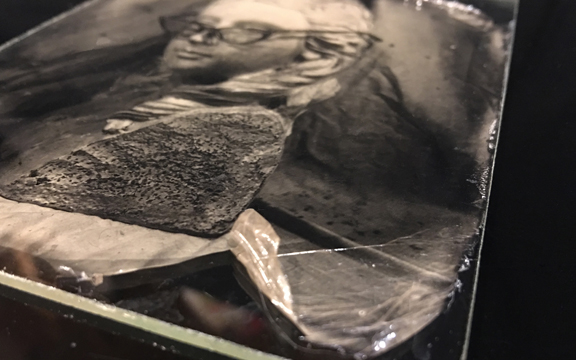Peeling & Lifting

The "usual suspect" for collodion that peels or lifts from the plate is a plate that has been inadequately cleaned. Wear nitrile gloves when handling the plates to avoid getting finger prints and oils on the glass while handling it. Scour the plate with a slightly abrasive cleanser like Bonami, and rinse thoroughly under running water until the water sheets off smoothly without forming little rivulets on the surface of the glass. Place the plate in a rack to dry. Prior to pouring the plate, use a mixture of alcohol and whiting (powdered calcium carbonate) to scrub the plate. Finish cleaning the plate by buffing it vigorously with a clean flannel cloth. Wipe all edges to remove any whiting that may have collected there while cleaning. Pour the freshly cleaned plate and process it. If you still find the collodion is peeling or lifting from the plate, try increasing the amount of alcohol in the collodion mixture as described below. Our second suspect is alcohol content. Generally, collodion (5% USP, as obtained commercially) is thinned for use in photography with equal parts of ether and alcohol. If the relative amounts of each solvent (ether and alcohol) are varied along a continuum from primarily ether (and very little alcohol) to primarily alcohol (and very little ether), one will find the collodion film to vary in physical character from tough and leathery to spongy and fragile. If too much ether is used, not only with the film be tough, but it will also be prone to shrinking on the order of 2.5% when it dries. This may not sound like much, but on a 10 inch plate, this is equivalent to 1/4 inch. It's this combination of shrinkage and leathery nature of the film that's responsible for the film peeling and sliding off the plate. To prevent this, it is necessary to increase the percentage of alcohol in the mixture. Begin by adding a volume of alcohol equivalent to 5% of the total collodion volume being used. Swirl the alcohol into the collodion mixture then pour and process a new plate. If peeling still occurs, add an additional 5% alcohol to the collodion and repeat. As more alcohol is added to the collodion, the film begins to lose its tough, leathery, character and becomes spongey and fragile. When all else fails...you can apply albumen to your plate prior to coating the plate with collodion. This process isn't particularly complicated, it just takes a little time and preparation. First, to get the albumen, you have three options: separate the white from an egg, buy a carton of egg whites from the grocery store, or purchase powdered egg white and add water. Separating the white from an egg is probably the the quickest solution since eggs are relatively close at hand for most folks. The quick and dirty solution is to dip a cotton swab into the albumen and paint the perimeter of the plate, making a border about 1/4 inch wide. Let this dry completely before coating the plate with collodion. This will keep your collodion from peeling, but it will leave a darker boarder around your print where the albumen was applied. A slightly more involved procedure is to mix the egg white with water in a ratio of about 1/40. This is approximately one egg white in 1 liter of water. Mix this thoroughly and filter before use. Pour this solution onto the plate as you would pour collodion. Avoid creating bubbles or trapping dust on the plate. Allow the plate to dry thoroughly before applying the collodion. This method avoids the dark border and insures that the collodion will stick to the glass.
